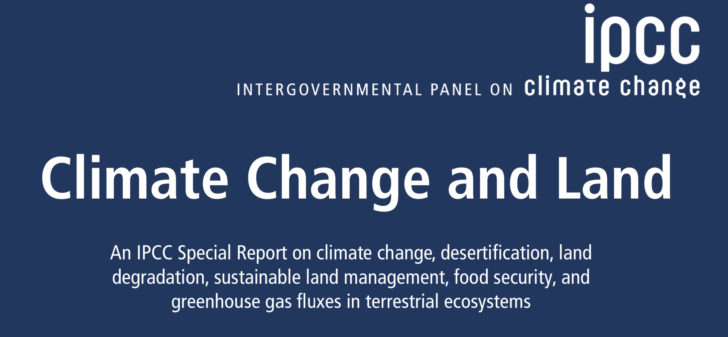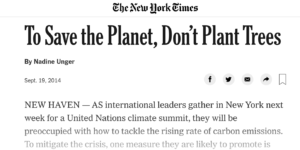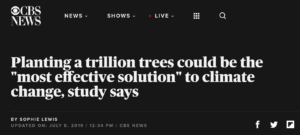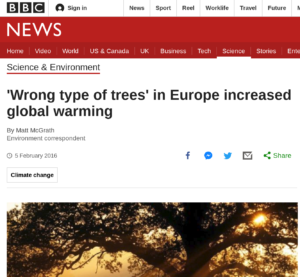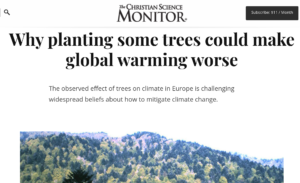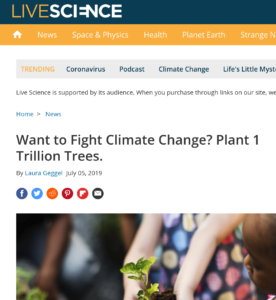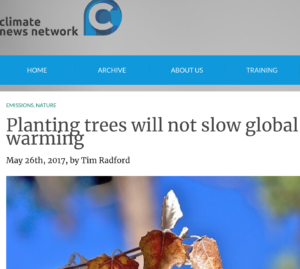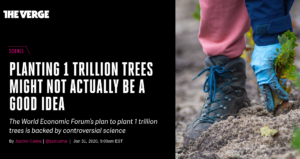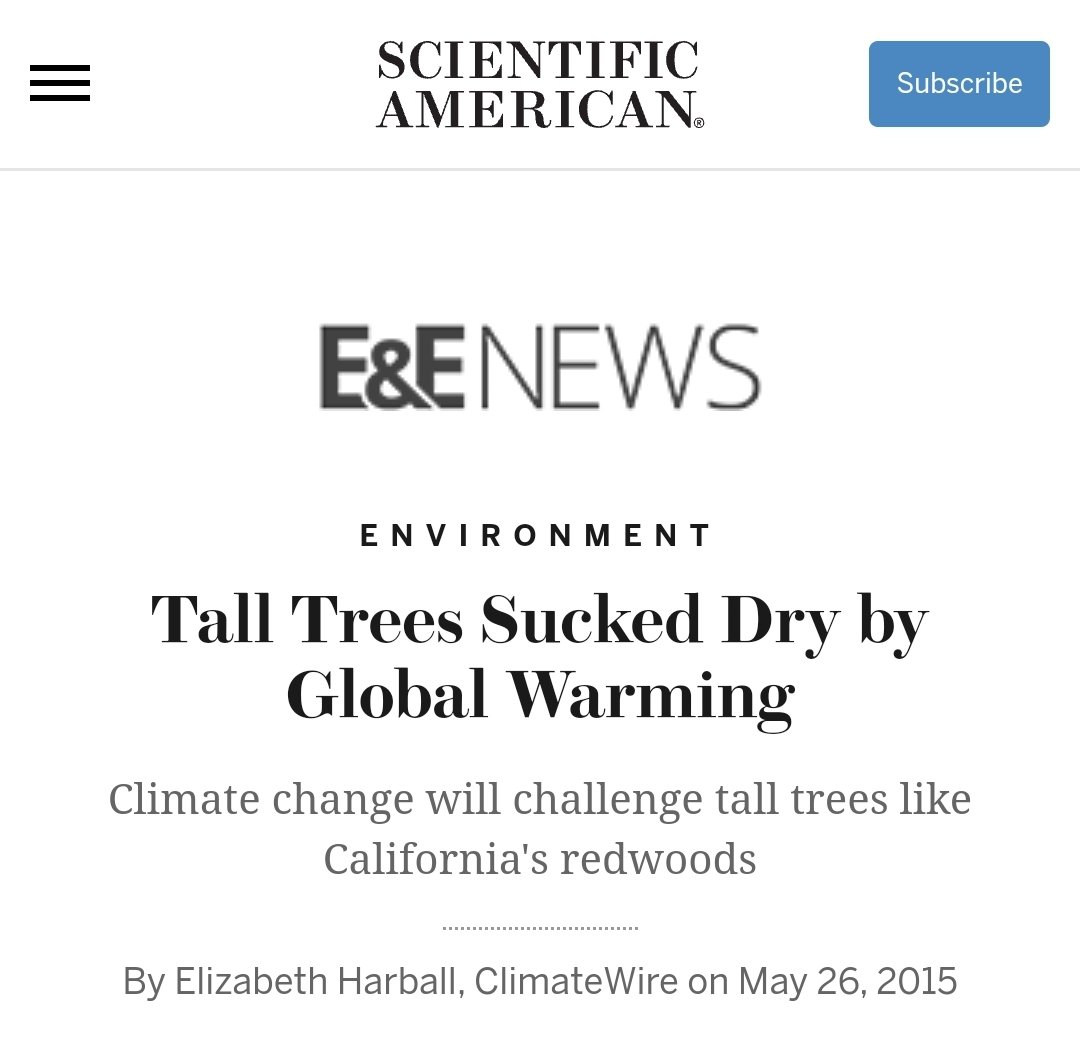Tree planting proposal & consequences Round up
Nature study except: “We find that global-scale deforestation has a net cooling influence on Earth’s climate, because the warming carbon-cycle effects of deforestation are overwhelmed by the net cooling associated with changes in albedo and evapotranspiration.“
#
GOP climate bill will seek to commit US to planting 3.3 billion trees annually
#
CEI’s Myron Ebell: “Scientific American in 2015 published results of a new study that estimated there are roughly three trillion trees on Earth, which interestingly is seven times more than the previous estimate of 400 million. Where are one trillion more trees going to be planted? There are major areas of deforestation globally, but quite a bit of that land is now used for farming. Cities occupy other deforested areas. In this country, the problem in our National Forests is far too many thickets of small trees. Scientists have also questioned how much carbon the world’s forests can actually sequester and for how long.”
Appeasement backfires as climate campaigners attack planting trees – By James Taylor: “GOP climate appeasers put themselves in a political box with no escape route. After publicly supporting speculative, dubious assertions of a climate crisis, they are accused by the Climate Establishment of proposing half-baked measures that do little to mitigate rising temperatures.”
The New Climate Consensus: Let’s Plant Trees: “The world’s business and government leaders may have found a way to fight climate change without having to call global warming by its name or agree on what is causing it.”
Germans On Course To Permanently Ruining Remaining Forests – To Protect The Climate
#
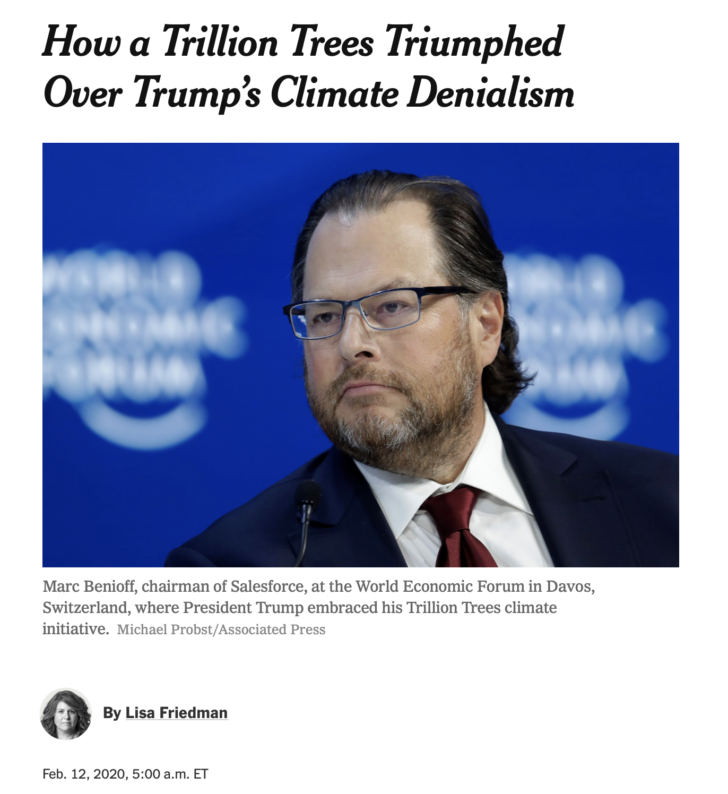
Steve Milloy of JunkScience.com: The NYT article and Trillion Tree Initiative are based on the notion that planting trees is some sort of climate “solution.” But readers of JunkScience know that this is false. And you don’t have to take my word for it — take the IPCC’s. Check out this IPCC report from August 2019.
The chart below (from Chapter 2) shows that deforestation in the Northern Hemisphere has a net warming effect (due to decreased albedo). That is, trees darken the Earth’s surface so as to absorb more solar UV (vs. lighter surfaces that reflect more UV), resulting in more infrared radiation being re-radiated into the atmosphere to be trapped by greenhouse gases.
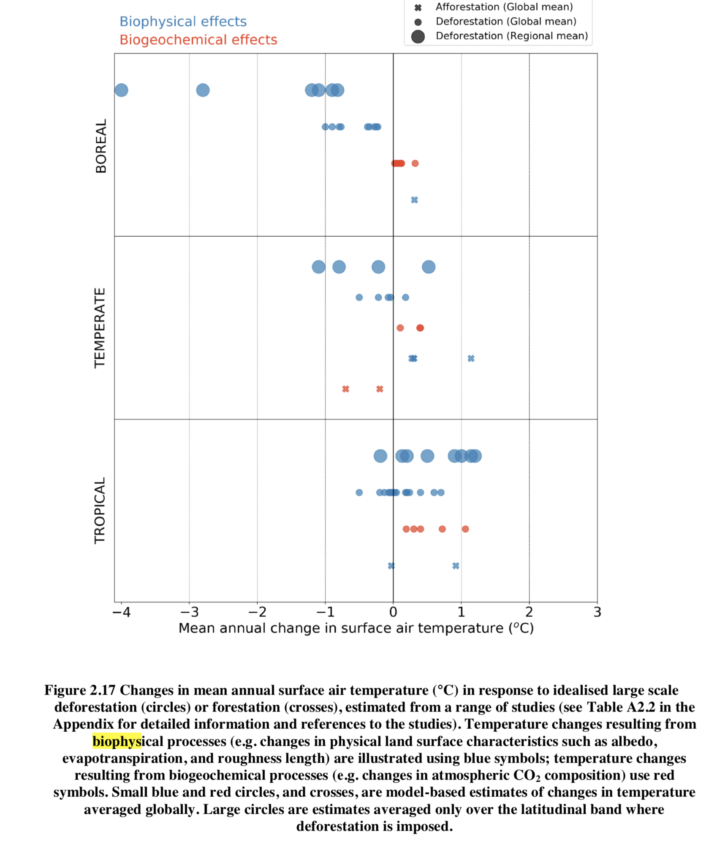
That’s right… trees cause global warming. This has been known for some time. I first wrote about it in a FOXNews.com column in 2007 based on a study in Nature. (Nature study except: “We find that global-scale deforestation has a net cooling influence on Earth’s climate, because the warming carbon-cycle effects of deforestation are overwhelmed by the net cooling associated with changes in albedo and evapotranspiration.“)
#
Nothing is wrong with planting trees! But selling it as some kind of climate 'solution' is wrong!
— Marc Morano (@ClimateDepot) February 12, 2020
NYT: To Save the Planet, Don’t Plant Trees – 2014 – Yale Atmospheric chemistry Prof. Nadine Unger:
“Deforestation accounts for about 20 percent of global emissions of carbon dioxide. The assumption is that planting trees and avoiding further deforestation provides a convenient carbon capture and storage facility on the land. That is the conventional wisdom. But the conventional wisdom is wrong…Considering all the interactions, large-scale increases in forest cover can actually make global warming worse…The dark color of trees means that they absorb more of the sun’s energy and raise the planet’s surface temperature…Their conclusion is that planting trees in the tropics would lead to cooling, but in colder regions, it would cause warming…Worse, trees emit reactive volatile gases that contribute to air pollution and are hazardous to human health. These emissions are crucial to trees — to protect themselves from environmental stresses like sweltering heat and bug infestations. In summer, the eastern United States is the world’s major hot spot for volatile organic compounds (V.O.C.s) from trees…The Amazon rain forest is often perceived as the lungs of the planet. In fact, almost all the oxygen the Amazon produces during the day remains there and is reabsorbed by the forest at night. In other words, the Amazon rain forest is a closed system that uses all its own oxygen and carbon dioxide…More funding for forestry might seem like a tempting easy win for the world leaders at the United Nations, but it’s a bad bet.”
Climate Depot note: So don’t plant trees? Wait, others claim planting trees will save us from ‘climate change.’
It’s all so confusing!
#
Scientists say planting a trillion trees globally could be the single most effective way to fight climate change. According to a new study in the journal Science, planting billions of trees around the world would be the cheapest and most effective way to tackle the climate crisis. Since trees absorb carbon dioxide, which contributes to global warming, a worldwide planting initiative could remove a substantial portion of heat-trapping emissions from the atmosphere.
BBC: ‘Wrong type of trees’ in Europe increased global warming – 2016
“Researchers found that in Europe, trees grown since 1750 have actually increased global warming. The scientists believe that replacing broadleaved species with conifers is a key reason for the negative climate impact.
Conifers like pines and spruce are generally darker and absorb more heat than species such as oak and birch. The authors believe the work has implications for current efforts to limit rising temperatures through mass tree planting.”
Christian Science Monitor: Why planting some trees could make global warming worse – 2016
A new study, published Thursday in the journal Science, shows that an expansion of forests towards dark green conifers in Europe has stoked global warming. The findings challenge the widespread view that planting more trees helps human efforts to slow the Earth’s rising temperatures. Apparently, not all trees have the same mitigating effect. “Two and a half centuries of forest management in Europe have not cooled the climate,” a team of scientists led by France’s Laboratoire des Sciences du Climat et de l’Environnement wrote.
Discover Mag: We Can’t Just Plant Billions of Trees to Stop Climate Change – 2019
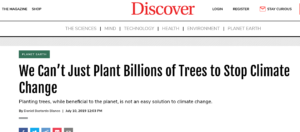
Live Science: Want to Fight Climate Change? Plant 1 Trillion Trees – 2019
“Want to help save the world from climate change? Then grab some seeds, or some seedlings, and start planting trees like there’s no tomorrow. At least 1 trillion of them, and fast.”
AP: Best way to fight climate change? Plant a trillion trees – 2019
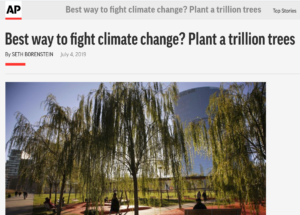
By SETH BORENSTEIN – (AP) — The most effective way to fight global warming is to plant lots of trees, a study says. A trillion of them, maybe more. And there’s enough room, Swiss scientists say. Even with existing cities and farmland, there’s enough space for new trees to cover 3.5 million square miles (9 million square kilometers), they reported in Thursday’s journal Science . That area is roughly the size of the United States.
Climate News Network: Planting trees will not slow global warming – 2017
2017 – Humans cannot simply plant their way out of trouble: trees cannot absorb the ever-increasing quantities of carbon dioxide in the atmosphere. If the world’s nations really do intend to contain global warming to within 2°C, there is no alternative to drastic cuts in greenhouse gas emissions, according to a new study.
Global warming may affect the capacity of trees to store carbon, 2011 study finds – “Global warming may affect the capacity of trees to store carbon by altering forest nitrogen cycling, concludes a study led by Jerry Melillo, Distinguished Scientist at the Marine Biological Laboratory (MBL) Ecosystems Center, and published this week in Proceedings of the National Academy of Sciences.”
Climate change may make trees live fast and die young | May 15, 2019
Scotland chopped down 13.9 million trees from 2000-2019 to erect windmills.
Very green.https://t.co/rhChMAgmjJ pic.twitter.com/ziEYiVzWVl
— Steve Milloy (@JunkScience) February 11, 2020
#
Update:
But now we are assured that nasty CO2 kills trees. Maybe makes others grow? Including Pinocchio's nose. pic.twitter.com/GCndNdEaAW
— Roger Payne (@rogermarksmen) September 10, 2020
BBC: Climate change: Planting new forests ‘can do more harm than good’
Will millions more trees really stop climate change?
‘A trillion trees to the rescue’
Trees ‘most effective solution’ for climate change
Is there any point in planting new trees?
House Republican Leadership Prepares Package of Climate Bills
Myron Ebell
Axios ran a story on January 20th by Amy Harder based on her exclusive interview with House Republican leaders planning a package of legislation to address climate change. House Minority Leader Kevin McCarthy (R-CA), Rep. Garret Graves (R-LA), ranking minority member on the Select Committee on the Climate Crisis, and Rep. Bruce Westerman (R-AR) talked with Harder after making presentations to a private House Republican caucus event on 16th January.
According to the Axios story, the package will include specific proposals grouped into three main areas: “1. capturing carbon dioxide emissions, with a focus on trees; 2. clean-energy innovation and funding; [and] 3. conservation, focusing on plastic.” The good news is that the package reportedly does not include taxes on carbon dioxide emissions or mandates to reduce emissions.
Westerman, a professional forester and member of the House Natural Resources Committee, has apparently sold McCarthy and Graves on the idea that forests sequester a lot of carbon and therefore Congress should support international efforts to plant one trillion trees. There are at least two branches of this effort. Trillion Trees was started by three major international conservation organizations—the World Wide Fund for Nature (WWF), the Wildlife Conservation Society, and Bird Life International. The other was launched by the World Economic Forum meeting in Davos, Switzerland on January 22nd. The press release noted that President Donald J. Trump in his Davos speech the day before announced that the United States would join One Trillion Trees.
I haven’t researched either effort yet, but I wonder whether the organizers have considered the ecological consequences of planting one trillion trees. Scientific American in 2015 published results of a new study that estimated there are roughly three trillion trees on Earth, which interestingly is seven times more than the previous estimate of 400 million. Where are one trillion more trees going to be planted? There are major areas of deforestation globally, but quite a bit of that land is now used for farming. Cities occupy other deforested areas. In this country, the problem in our National Forests is far too many thickets of small trees. Scientists have also questioned how much carbon the world’s forests can actually sequester and for how long, but I’ll leave that issue to another day.
The second basket of Republican proposals includes more taxpayer dollars for research and handouts to special interests. As for the third basket, it’s not clear what plastic has to do with global warming. I’ll only say that pollution of the oceans with plastic refuse is a real environmental problem that can largely by solved by ending the practice in China and other Asian countries of dumping huge amounts of garbage into rivers.
Harder’s story concludes with subtle (and appropriate) ridicule from an amusing source: “The Bipartisan Policy Center, a centrist D.C.-based think tank, has been working with Republicans on some of these ideas. ‘I think once you become engaged with the solution, then math starts to matter,’ said Jason Grumet, the group’s president. ‘Sure, you can start with aggressive gardening, but that’s not a complete solution and serious people then recognize that more has to happen.'”
#
How House Republicans won over conservatives to gain consensus on a climate agenda – “Climate denial is a bad political strategy,” said Florida Rep. Matt Gaetz, a 37-year-old member of the conservative House Freedom Caucus and an ally of President Trump. “At some point, you have to be for something to fix it.”
…
Outside conservative groups and more liberal GOP members left out of negotiations, however, promise to test House Republicans’ projection of unity.
Myron Ebell, director of the Center for Energy and Environment at the Competitive Enterprise Institute, dismissed McCarthy’s effort as a toothless messaging agenda of “wasting taxpayer dollars to pay off special interests and nutty plans to plant a trillion trees.” “I would have to be convinced that global warming is a crisis and that carbon dioxide emissions must be reduced before supporting such a package,” Ebell said.
#
“The big problem I have with this is the carbon capture concept,” says Climate Depot’s Marc Morano, who is a skeptic of catastrophic man-made climate change. “What they’re basically saying is ‘carbon dioxide is some kind of problem.'”
Some in GOP look to counter Green New Deal with three-pronged climate plan – 1) Carbon capture, plant trees 2) Promote ‘clean energy’ 3) Fight plastic waste – Some GOP members of Congress’ 3 part plan: The first is the capturing of carbon dioxide emissions…The plan does not include emissions targets that are favored by Democrats.
The second part of the plan is the promotion of clean energy technology
The third area of focus is conservation, especially when it comes to plastic.
#
PLANTING 1 TRILLION TREES MIGHT NOT ACTUALLY BE A GOOD IDEA
Excerpts: Ddozens of scientists have warned that planting all those trees could potentially cause more harm than good…the science behind the campaign, a study that claims 1 trillion trees can significantly reduce greenhouse gases, is disputed. “People are getting caught up in the wrong solution,” says Forrest Fleischman, who teaches natural resources policy at the University of Minnesota and has spent years studying the effects of tree planting in India.
…
Tree-planting started really trending in 2019, when a study published in the journal Science caused a commotion. It claimed that planting a trillion trees could capture more than a third of all the greenhouse gases humans have released since the industrial revolution. After the initial media blitz rallied excitement for the seemingly simple climate solution, a group of 46 scientists, including Fleischman, responded to the study with their critique.
“THOSE HEADLINES WERE WRONG” – “Headlines around the world declared tree planting to be the best solution to climate change,” lead author of the critique Joseph Veldman said in a statement at the time. “We now know those headlines were wrong.” Veldman argued that planting trees where they don’t belong can harm ecosystems, make wildfires worse, and even exacerbate global warming. His critique made the case that the amount of carbon the study said 1 trillion trees could sequester was about five times too large. The study also considered planting trees on savannas and grasslands, where planting non-native trees could cause problems for local species. Planting trees on snowy terrain that once reflected the sun could even turn those places into dark patches that actually absorb heat.
…their skepticism mostly centers around efforts to plant trees in places they weren’t before, or to plant large swaths of a single species to essentially create “tree plantations” instead of real forests…
In India, leading environmental groups opposed a project to plant 2 billion trees in the Cauvery river basin supported by the Leonardo DiCaprio Foundation. They claimed in a letter that the campaign threatened to dry up streams and destroy habitats. People who live alongside and depend on the river would be affected too, says Prakash Kashwan, a political science professor at the University of Connecticut.
#
Rep. Bruce Westerman’s fact sheet on the trillion trees bill:
Trillion Trees Act Section-By-Section
Section 1 – Short Title; Table of Contents
Section 2 – Sense of Congress
- Establishes a sense of Congress to support the UN’s TrillionTrees Initiative, and calls on the federal government, corporations, and U.S. citizens to take an active role in reforestation efforts
Section 3 – Definitions
Title I – Carbon Sequestration Through Reforestation Activities
Section 101 – National Wood Growth Targets
- Directs the Secretary of Agriculture to establish targets for total increased wood growth on our domestic forests for the purpose of capturing and storing carbon
- The targets, which will be informed by a report for the Natural Reforestation Task Force, will account for both natural and directed regeneration, and will not negatively impact timber harvest on National Forestland
Section 102 – National Reforestation Task Force
- Establishes the National Reforestation Task Force, which will advise the Secretary in establishing the National Wood Growth Targets and provide oversight on the policies enacted to achieve those targets
Section 103 – Timber Survey Update
- Updates the Forest Service’s Renewable Resource Planning Assessment Timber Survey to include stored carbon in the assessment
- Directs Forest Service to conduct at lifecycle analysis to study the carbon sequestration potential associated with active management of the National Forest System
Section 104 – Reforestation Programs
- Increases the authorization for the Reforestation Trust Fund and prioritizes reforestation following adverse events like wildfires or large mortality events
- Adds reforestation activities to Stewardship Contracting and the Good Neighbor Authority
Section 105 – Carbon Storage Through the Healthy Forest Reserve Program
- Adds carbon storage to the Healthy Forest Reserve Program, allowing for USDA to assist private landowners in storing carbon through active forest management through easements, 30-year contracts and 10-year cost-share agreements.
Section 106 – National Forest Foundation Activities
- Expands the authority of the National Forest Foundation, allowing the Foundation to accept and encourage private donations for reforestation, carbon storage, and pursuit of the Trillion Tree
Initiative
- Establishes the Pinchot Medal for Forest Restoration, allowing the Foundation to recognize outstanding private contributions of reforestation and forest carbon sequestration
- Establishes the Fifth Grade Forestry Challenge, directing the Foundation to partner with private companies to create an educational grant program which will provide 5th graders with a seedling to plant and teach the value of active management in storing carbon
Section 107 – Global Climate Change Program
- Adds carbon storage and forest management to the list of technical assistance categories under the Global Climate Change Program
Section 108 – International Forestry Cooperation
- Adds carbon storage and forest management to the list of technical assistance categories under the International Forestry Cooperation Program
Section 109 – International Engagement
- Establishes the International Forest Foundation, a nonprofit within U.S.A.I.D., which will encourage and accept private donations to support international reforestation and deforestation prevention
Section 110 – Modifications to Authorities Relating to Tropical Forests
- Adds carbon storage and forest management to the list of assistance categories under the Tropical Forests section of the Foreign Assistance Act
Title II – Carbon Storage Through Improved Forest Management Activities
Section 201 – Carbon Storage Through Land use Planning; Supplements to Programmatic Environmental Impact Statements
- Directs USFS to establish programmatic EIS’s for four project categories: Wildland Urban Interface Projects, Watershed Protection Projects, Critical Infrastructure Projects, and Wildlife Restoration Projects
- Under the established programmatic EIS, if the secretary determines that a proposed forest management project has been sufficiently analyzed, then no further NEPA review is required
Section 202 – Emissions Consideration of Management Injunctions
- Requires any federal court considering an injunction on a federal forest management project to consider both the potential for decreased carbon storage on federal land due to stand stagnation, and the potential for increased carbon emission from federal land due to wildfire
- Such consideration will utilize the carbon lifecycle analysis established in Section 103
Section 203 – Storing Carbon On State and Private Forests
- Adds carbon storage to several state and private forest management programs including the Cooperative Forestry Assistance Program, the State Assessment and Strategies Program, the
Forest Stewardship Program, the Forest Legacy Program, the FIREWISE Program, the Communicy Forest and Open Space Conservation Program, and the Urban and Community Forestry Program
Section 204 – Carbon Storage Through The Good Neighbor Authority
- Adds Carbon Storage to the Good Neighbor Authority and makes program permanent
Section 205 – Carbon Storage Research Program
- Adds forest carbon storage, increased carbon storage through wood utilization, and increased carbon storage through active management to the Renewable Research Assessment under the Forest and Rangeland Renewable Resources Research Act
Title III – Market Incentives for Carbon Storage
Section 301 – Sustainable Buildings and Residence Credit
- Establishes a transferable tax credit to promote the use of building materials which store carbon
Directs the Secretary of Energy to develop a sustainability score for both commercial and residential buildings, accounting for the energy required
- to produce and deliver construction materials, the energy required to operate the building, and the amount of carbon stored in any domestically-produced components of the building
- Establishes an advisory board to assist the Secretary of Energy in the creation of a sustainability score
- Directs the Secretary of Energy to establish a carbon storage certificate, which will certify to the taxpayer the amount of carbon stored in a building or residence
Section 302 – Utilizing Biomass Energy to Reduce Global Carbon Emissions
- Adjusts the Clean Air Act to allow for both federal biomass, private non-plantation wood products, wood product residuals, and comingling of feedstocks in the biocrude refinement process
Section 303 – Carbon Neutrality of Sustainable Biomass
- Directs the Administrator of the Environmental Protection Agency to establish policies reflecting the carbon neutrality of biomass
Section 304 – Clarification of Research and Development Program for Cellulosic Biochemical and Bioplastics
- Establishes a competitive grant program to increase research into advanced wood bioproducts including biofuels, biochemicals, and bioplastics
#
Related:
Germans On Course To Permanently Ruining Remaining Forests – To Protect The Climate
GOP Appeasement backfires as climate campaigners attack planting trees – By James Taylor:
Excerpt: “Other websites allied with the Environmental Left have also been critical of climate plans focused on planting trees. A Vice article is titled, “Planting ‘Billions of Trees’ Isn’t Going to Stop Climate Change” (https://www.vice.com/en_us/article/7xgymg/planting-billions-of-trees-isnt-going-to-stop-climate-change). “Trying to Plant a Trillion Trees Won’t Solve Anything,” claims a Wired headline (https://www.wired.com/story/trees-regenerative-agriculture-climate-change/). “Republicans’ Climate Change Plan Is Big Oil’s Climate Change Plan,” claims a New Republic headline (https://newrepublic.com/article/156269/republicans-climate-change-plan-big-oils-climate-change-plan).
GOP climate appeasers put themselves in a political box with no escape route. After publicly supporting speculative, dubious assertions of a climate crisis, they are accused by the Climate Establishment of proposing half-baked measures that do little to mitigate rising temperatures. And once they have stated that climate change is a serious problem – indeed a crisis – they will be boxed into supporting virtually anything the Environmental Left proposes. After all, if the GOP joins alarmists asserting climate change is an existential crisis that is the greatest-ever threat to human civilization, the public will demand the most immediate and far-reaching responses. There is no proposal too far-reaching if we are facing a climate apocalypse, and Republicans will be politically destroyed for proposing anything less.
Ultimately, Republicans should stand true to the science, which provides overwhelming evidence that we are not facing a climate crisis.”
#
Wut??? pic.twitter.com/ypbbzHDNMj
— 𝔻𝕒𝕨𝕟𝕋𝕁𝟡𝟘™ 🇵🇭💖🇨🇦 Climate of Dawn (@DawnTJ90) May 10, 2022

